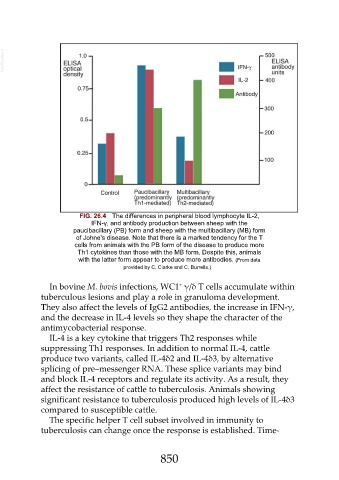Page 850 - Veterinary Immunology, 10th Edition
P. 850
VetBooks.ir
FIG. 26.4 The differences in peripheral blood lymphocyte IL-2,
IFN-γ, and antibody production between sheep with the
paucibacillary (PB) form and sheep with the multibacillary (MB) form
of Johne's disease. Note that there is a marked tendency for the T
cells from animals with the PB form of the disease to produce more
Th1 cytokines than those with the MB form. Despite this, animals
with the latter form appear to produce more antibodies. (From data
provided by C. Clarke and C. Burrells.)
+
In bovine M. bovis infections, WC1 γ/δ T cells accumulate within
tuberculous lesions and play a role in granuloma development.
They also affect the levels of IgG2 antibodies, the increase in IFN-γ,
and the decrease in IL-4 levels so they shape the character of the
antimycobacterial response.
IL-4 is a key cytokine that triggers Th2 responses while
suppressing Th1 responses. In addition to normal IL-4, cattle
produce two variants, called IL-4δ2 and IL-4δ3, by alternative
splicing of pre–messenger RNA. These splice variants may bind
and block IL-4 receptors and regulate its activity. As a result, they
affect the resistance of cattle to tuberculosis. Animals showing
significant resistance to tuberculosis produced high levels of IL-4δ3
compared to susceptible cattle.
The specific helper T cell subset involved in immunity to
tuberculosis can change once the response is established. Time-
850

